
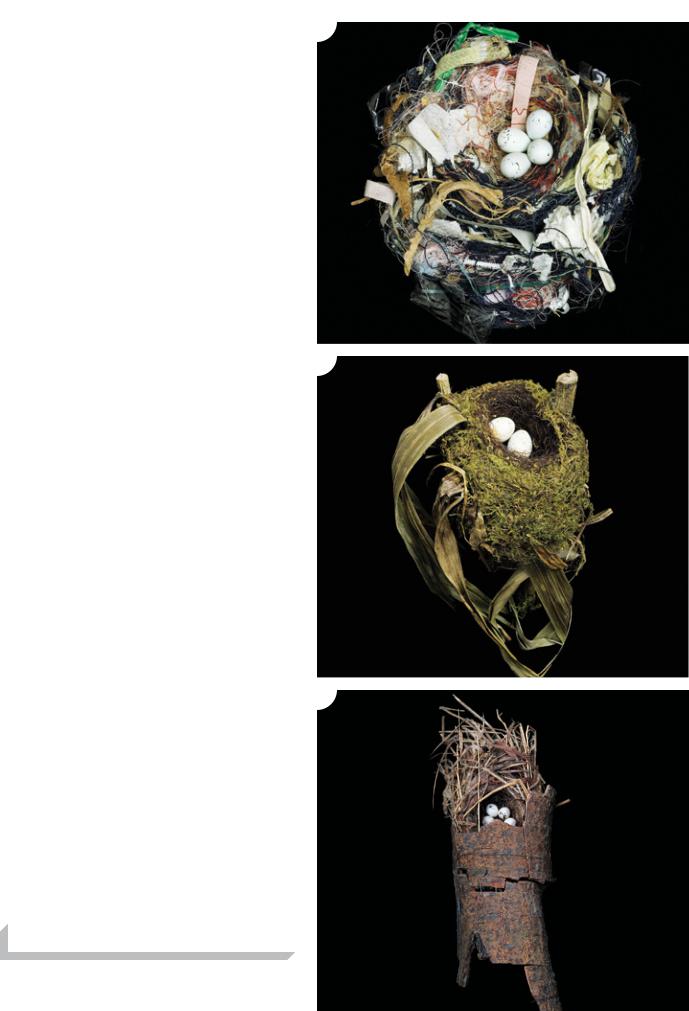
1
L I F E S C I E N C E
TREASURE IN THE TREES
Nests offer clues about natural history, climate change and their owners’ mating habits
By Nina Bai
rom twigs and grasses to sheep’s wool and horse- |
|
hair, birds weave their world into their nests. The |
|
homes they leave behind thus provide clues about |
4 |
their lives and their environment, much as archaeo- |
|
logical sites supply glimpses of human history. |
|
FThe architectural diversity of nests has been used to un- |
|
tangle the complex genealogy of South American song- |
|
birds; remnants of prey found in bald eagle nests have re- |
|
vealed the birds’ food habits; and carbon dating of feathers |
|
and droppings in ancient falcon nests has yielded evidence |
|
for the timing of ice-sheet retreats in Greenland. Ongoing |
|
research, including a paper published in the journal Sci- |
|
ence earlier this year, shows that birds use nest decor to |
|
compete for mates and communicate with one another |
|
more often than previously recognized. |
|
Nest collecting was a popular boyhood hobby in the |
|
19th century but is now banned throughout much of the |
|
world. Most of the images here come from Nests: Fifty |
|
Nests and the Birds That Built Them (Chronicle Books, |
|
2011), in which photographer Sharon Beals showcases |
|
samples from museums. Lloyd Kiff, a former director of the |
|
Western Foundation of Vertebrate Zoology in Los Angeles |
|
(which holds the world’s largest collection, with 18,000 |
|
specimens), says that nests remain a largely untapped sci- |
|
entific resource. They are not just for the birds. |
7 |
Nina Bai is a science writer based in New York City.
Field notes: ● House Finch (Arizona, 1965); thread, paper, twist ties. ● Small Ground Finch (Galápagos Islands, 1906); grass, twigs, wild cotton. ● Verdin (Mexico, 1961); prickly twigs, spiderweb. ● Spotted Nightingale Thrush (Mexico, 1968); moss, lichen, leaves. ● Gray Jay (Colorado, 1938); twigs, cocoons, lichen, bark, fur, feathers. ● American Dipper (California, 1951); moss, grass, leaves, bark.
● MacGillivray’s Warbler (California, 1920); grass inside bark. ● Western Tanager (Nevada, 1934); twigs, bark, pine needles, animal hair. ● House Wren (California, 1974); twigs, fine grass, skeletons of abandoned runt chicks.
SCIENTIFIC AMERICAN ONLINE
More images and readings at ScientificAmerican.com/aug2011/nests
66 Scientific American, August 2011 |
Photographs by Sharon Beals |
© 2011 Scientific American
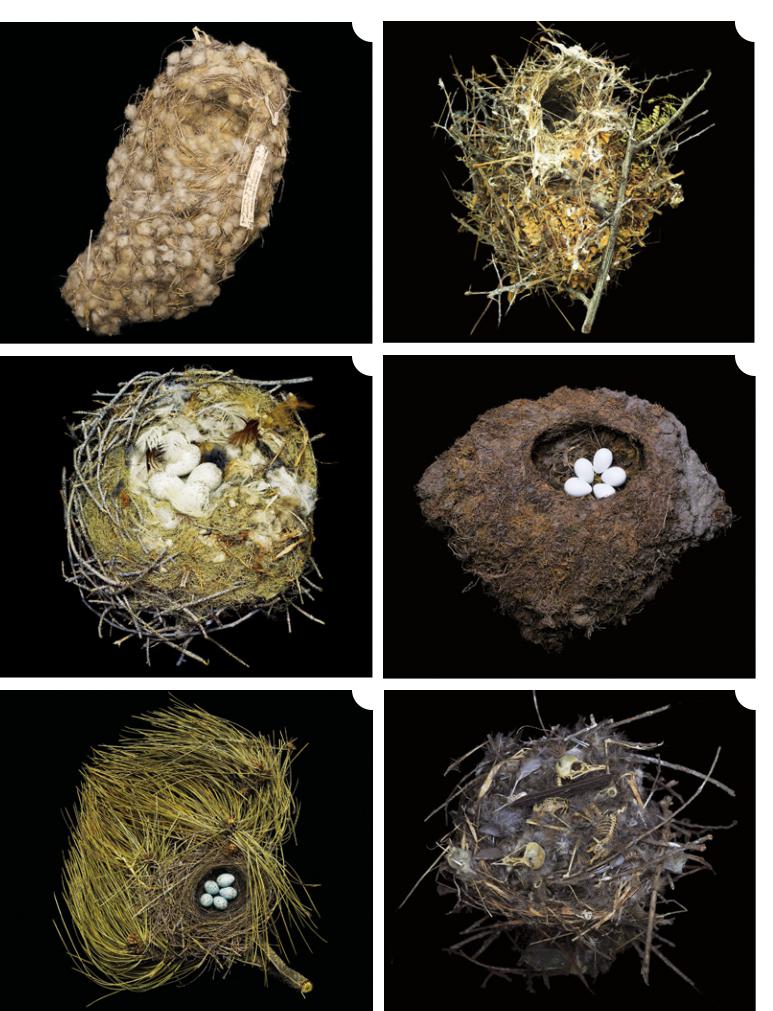
2 |
3 |
5 |
6 |
8 |
9 |
© 2011 Scientific American
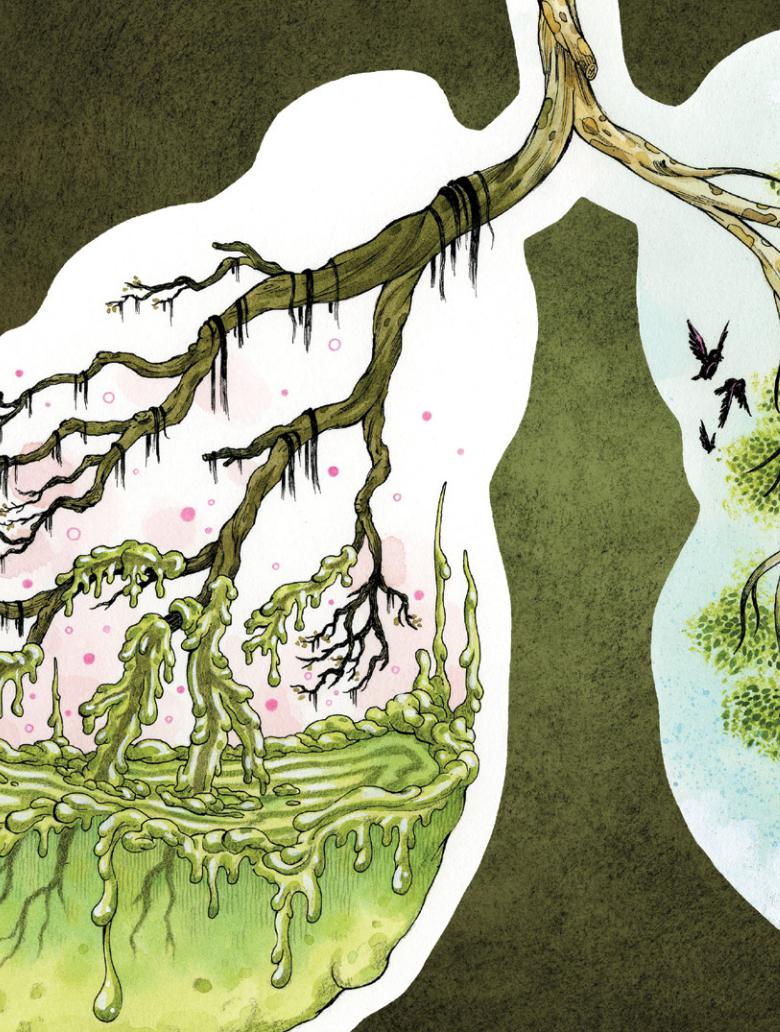
© 2011 Scientific American
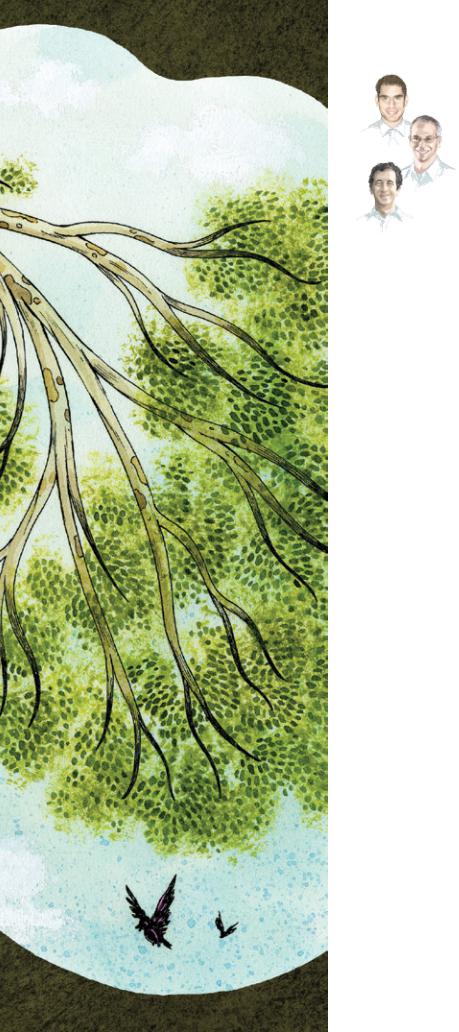
Steven M. Rowe is an assistant professor of medicine, pediatric pulmonology, and physiology and biophysics at the University of Alabama at Birmingham.
J. P. Clancy is a professor of pediatric pulmonary medicine at Cincinnati Children’s Hospital Center and the University of Cincinnati.
Eric J. Sorscher is a professor of medicine and a professor of physiology and biophysics at the University of Alabama at Birmingham.
MAE D I C I N E
BREATH OF FRESH AIR
Fundamental understanding of basic biology has set the stage for new treatments for cystic fibrosis
By Steven M. Rowe, J. P. Clancy
and Eric J. Sorscher
Illustration by John Hendrix |
August 2011, ScientificAmerican.com 69 |
© 2011 Scientific American

In 1989 when scientists discovered the defective gene that causes cystic fibrosis, a serious hereditary disorder that primarily strikes children of European descent, it seemed as though a long-hoped-for cure might soon follow. After all, tests in many laboratories showed that providing normal copies of the gene should enable patients to make healthy copies of the protein specified by the gene. If successful, that feat would go a long way toward restoring health in the tens of thousands of people around the world who suffered from cystic fibrosis and typically died in their late 20s. (Half of all patients now live
to their late 30s or beyond.) The question was whether researchers would be able to reliably insert the correct gene into the proper tissues in patients’ bodies to rid them of the illness forever.
That task proved harder than anyone had believed. Although scientists successfully engineered viruses to ferry copies of the correct gene into patients’ cells, the viruses did not do the job well. By the late 1990s additional unexpected complications made it increasingly obvious that another approach to addressing the fundamental problem in cystic fibrosis would need to be found.
Meanwhile cell biologists and their colleagues undertook the long, challenging task of determining exactly what the normal protein looked like, how it functioned and how defects led to the symptoms of cystic fibrosis. These efforts included understanding the protein’s three-dimensional shape in increasingly fine detail as well as the various ways the abnormal protein failed in its cellular duties. Instead of creating normal proteins by replacing the broken gene with an effective one—as was gene therapy’s goal—this group of researchers focused on a different objective: finding a drug that allowed the deficient protein to work better. A fruitful search might give people with cystic fibrosis many additional years of a healthier life.
Today it looks as though the gradual but steady approach is paying off. Several new compounds are in the final stages of being tested for use in the treatment of cystic fibrosis—and one of them looks particularly promising for certain patients. If successful, it would be the first medication that targets the under-
lying cause of the disease, as opposed to dealing with symptoms. But that is not all. Preliminary studies indicate that these potential new treatments may also work against other, more common conditions, such as bronchitis, chronic sinusitis and pancreatitis, among others.
A PROBLEM WITH SALT
the story of how these drugs were identified begins with a dogged search to understand the basic biology of cystic fibrosis. The disease has long been known to result generally from a failure in the ability of certain body tissues to transport salt (sodium chloride) across the membranes that envelop cells. The cells in these tissues extrude the chloride part of the salt to help maintain the right balance between their fluid-filled interior and the watery exterior environment. As the chloride ions accumulate on the outside of the cell, water molecules follow suit, diffusing across the membrane to the outside. When the cell is finished constructing these tiny chloride channels, it inserts them into the membrane, where each protein forms a passageway that spans the cell border.
The gene that in 1989 was found to cause cystic fibrosis codes for one of these proteins, known as the cystic fibrosis transmembrane conductance regulator, or CFTR. The normal version of this molecule is made of a precise sequence of ap-
Cystic fibrosis is a serious hereditary disorder that fills certain organs in the body with a sticky mucus that interferes withtheabilitytodigestfoodorbreathe.
I N B R I E F
When researchers discovered the gene |
Thereweresetbacks.Butanewanddif- |
thatcausescysticfibrosisin1989,along- |
ferent approach is now poised to deliver |
hoped-for cure—in the form of gene |
the first medications that address the |
therapy—seemedpossible. |
fundamentalcausesofthedisorder. |
The Food and Drug Administration will probably begin to consider whether to approve a drug based on this latest researchthisyear.
70 Scientific American, August 2011
© 2011 Scientific American
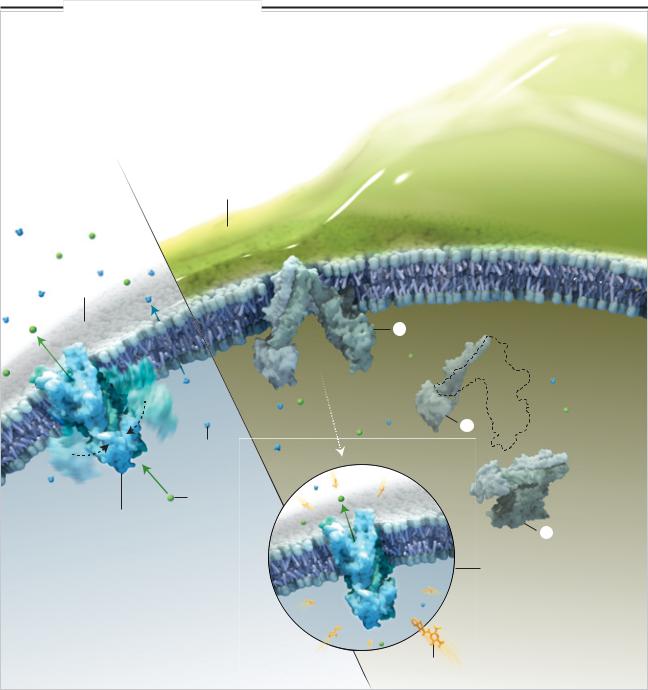
ANATOMY OF GENE DEFECT
Pathways to Trouble
To survive, cells constantly adjust their internal environment, such as by actively moving chloride ions out of the cell through a membrane-spanning protein called the CFTR channel. Mutations in the gene coding for this channel can lead to cystic fibrosis.
Thickmucusbuildup
Thin mucus
Water molecule
Chloride ion
Functioningchloridechannel(CFTR)
Normal Chloride Channel
As chloride ions accumulate on the outside of cells,watermoleculesdiffusefrominsidethe cell across the membrane to the exterior. This fluidhydratesthemucusthatbathesthesurfaces of cells in the lungs, intestines and other organs. The mucus traps pollutants and bacteriasotheycanbesweptoutofthebody.
Abnormal Chloride Channel
Mutationsinthecysticfibrosisgenecause illnessinseveralways,suchasbyleadingto production of CFTR channels that are permanentlyblocked(a),truncated(b) or misfolded (c).Theresult:anabnormallythickmucus thattrapsbacteriainplace(increasinginfectionrisk)andblockssmallerairways,preventingnormaloxygenationofblood.
a BlockedCFTR
VX-770
b Truncated CFTR
c Misfolded CFTR
Help Is on the Way
AnexperimentaldrugcalledVX-770 mayhelpeasetheillnessforsomebut notallpatients.Thecompoundopens theCFTRchannelinthoseindividuals whosechloridechannelisblocked shut.Otheragentsarebeingdeveloped totackletheproblemsoftruncatedor misfoldedCFTRproteins.
proximately 1,500 amino acids folded intricately and gracefully into a series of three-dimensional loops and sheets that spiral or plunge to form a number of different subsections. The flow of water molecules elicited by the movement of chloride ions through the channel helps to move the mucus that coats the surfaces of the body’s airways, as well as the many ducts found in the intestines, pancreas and liver. The CFTR channel can also transport certain other ions, such as bicarbonate.
Here is where the trouble starts. Mutation of the gene results in the body lacking a proper CFTR channel. As a result, people with cystic fibrosis produce a sticky mucus that is so
thick it interferes with many physiological processes. In the lungs, the gel-like mucus hampers the diffusion of oxygen into the air sacs and makes the simple act of breathing, as one of our young patients described it, like “trying to breathe with someone’s hands over your face.” Furthermore, the viscous buildup becomes an ideal breeding ground for serious infections by harmful bacteria, often Pseudomonas aeruginosa. In the pancreas, the thick and immobile secretions prevent the passage of digestive enzymes through various ducts into the intestines, interfering with proper digestion and, as a result, frequently causing people with cystic fibrosis to be underweight
Illustration by AXS Biomedical Animation Studio |
August 2011, ScientificAmerican.com 71 |
© 2011 Scientific American
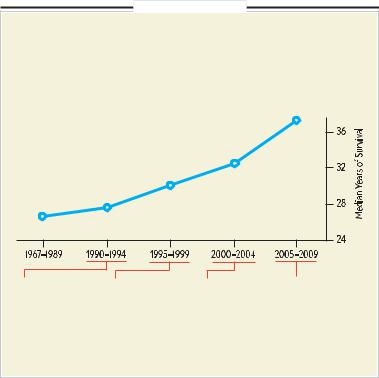
normal length is made but is unable to open or transport chloride or other ions. A single drug developed to repair one of these problems might not be of much help for the other two. Therefore, it is likely that to help the entire population of cystic fibrosis patients, different drugs will need to be developed— each based on the genetic defect responsible for an individual’s condition.
A completely missing chloride channel at the cell surface stems from the most common genetic mutation, which results in the deletion of just one of the channel’s 1,500 amino acid building blocks. Because the missing amino acid is phenylalanine (designated “F” in protein parlance) and is the 508th amino acid in the chain, the mutation is referred to as F508del.
The F508del mutation causes disease in a fashion that was at first surprising. Despite the mutation, the cell is able to build a chloride channel, amino acid by amino acid. The final product is equipped to transport chloride ions to a limited extent. But the cell’s own molecular quality-control apparatus prevents it from doing so. The cell has several hundred helper proteins and enzymes that ferry the nascent CFTR molecules around the cell, inspect the ways they are being folded and help to insert CFTRs in the cell membrane. Even seemingly minor defects in folding—such as the F508 omission—can be rapidly recognized, leading the cell to quickly destroy the mutant. As a result, the somewhat functional chloride channel never even makes it to the cell membrane.
Because F508del is the most common cause of cystic fibrosis, numerous facilities around the world (including our own) are trying to locate the precise cellular checkpoints at which the F508del CFTR molecule fails to “make the grade” and is routed to the recycling bin. The goal is to aid in the discovery of compounds that will ease cystic fibrosis by helping the protein
fold correctly and avoiding its destruction without interfering with the ability of the cells to recognize and eliminate other aberrant amino acid chains.
Figuring out how to adjust the cell’s quality- control systems could offer benefits beyond treating cystic fibrosis. A number of chronic diseases—such as defects in cholesterol metabolism and some lung disorders (among them, alpha-1-antitrypsin deficiency)—occur
because of protein misfolding. In at least cer-
tain diseases, evidence is growing that the
true culprit is not the altered function of the
protein per se but rather the propensity of the
quality-control mechanism to degrade the ab-
normal molecule or deposit it in a tangled clump. It is conceivable that a number of slightly misfolded, mutant proteins would retain significant function if they were spared and allowed to do their intended jobs. Therapies that tackle the quality-control mechanism might therefore provide valuable insight into the biology and treatment of a wide range
of diseases.
Mutations that result in abnormally foreshortened CFTR channels account for about 10 percent of cystic fibrosis cases worldwide. One
SOURCE: CYSTIC FIBROSIS FOUNDATION PATIENT REGISTRY: ANNUAL DATA REPORT 2009
Graphic by Jen Christiansen

such genetic defect, dubbed W1282X, underlies about 40 percent of cystic fibrosis in Israelis. The protein ends up being truncated because the gene contains misguided instructions telling the protein-synthesizing machinery to stop attaching amino acids to the growing protein molecule at position 1282 in the chain, where the amino acid tryptophan (signified by “W”) would normally reside. Such genetic instructions are called nonsense codons and are crucial to the proper manufacture of proteins—provided they occur in the right place. In this case, however, the protein-manufacturing process comes to a premature halt. In addition, the intermediate instructions (known as messenger RNA) that guide the production process are also recognized as abnormal and destroyed so that even if the stop signal could somehow be skipped over, not enough of the now functional protein would be made. Therefore, drug treatments for W1282X may need to attack two problems and not just one.
The last set of mutations we consider here disables the channel’s ability to open and accounts for about 5 percent of cystic fibrosis cases worldwide. In effect, these mutations cause the doorway through the membrane to be stuck in the closed configuration, which leaves the channel less able to transport chloride ions to the extracellular environment. One of the mutations that act in this way (called G551D) causes particularly severe symptoms. Although it is generally true that each group of genetic defects may require its own specifically targeted treatment, researchers have shown that compounds designed to prop open a mutant CFTR gate might aid patients who do not have this mutation. For example, take the case of a drug that enabled a small amount of the F508del CFTR to travel to its proper location in the cell membrane. A second drug that braced the channel door open would allow this somewhat sluggish version of the channel to pass more chloride out of the cell.
PROMISING DRUG CANDIDATES
the next step in the long process of drug development was to search for compounds able to alleviate the effects of specific mutations in the CFTR gene. It made sense to start with F508del because of its high prevalence in patients with cystic fibrosis and because the resulting protein retains some residual functionality; if researchers could help F508del CFTR evade premature degradation, the protein could arguably provide partial activity and improve lung function without further prodding.
Knowledge of the ways the F508del CFTR protein misfolds and of how the cell’s quality-control machinery detects that folding defect is far from complete. It is, however, reasonably straightforward to determine whether a particular compound can alleviate the effects of the folding error in human cells. By loading fluorescent molecules into a cell, investigators can measure small changes in the concentrations of chloride or other ions moving across the cell membrane. When ions traverse the membrane after exposure to a potentially therapeutic drug, researchers can infer that the impaired CFTR channel has regained some function. If the ions do not make it across, the search continues for a more active compound. By automating and computerizing the drug-screening process, millions of compounds can be analyzed in a relatively short time.
Biotechnology company Vertex Pharmaceuticals identified one compound, known as VX-809, that had encouraging preliminary results but that did not significantly improve lung
function in test subjects. Another company, PTC Therapeutics, is directing clinical trials of a drug called ataluren that addresses the less common, CFTRtruncation mutations. This agent causes the protein-making machinery to read through some of the misplaced “stop” instructions, thereby allowing the chloride channel protein to avoid being foreshortened. This agent is also being tested for other hereditary disorders that involve aberrant stop codes, such as Hurler syndrome and Duchenne muscular dystrophy.
Scientists have had the best results counteracting the G551D mutation. After testing 228,000 different potential compounds against cells harboring chloride channels that did not open easily, a group of researchers at Vertex discovered a compound that selectively activates the energy switch of the CFTR channel, boosting function to 50 percent of normal levels. The laboratory results were good, and the compound, named VX-770, has now undergone extensive testing. In these trials, the ability to breathe improved substantially in patients with the G551D mutation within weeks, and the benefits were sustained for the length of a one-year study. Just as important, treated individuals were hospitalized less often and gained an average of seven to eight pounds. One of us (Rowe) was the first clinician in the U.S. to administer VX-770 in a patient. Sometime later this year Vertex plans to petition the Food and Drug Administration for the right to bring the drug to market. Further testing to use VX770 in combination with other agents is also showing some promise in clinical trials. (The University of Alabama at Birmingham is one of the sites for clinical trials of drugs developed by PTC Therapeutics and Vertex; Rowe and Clancy have advised both companies about study design.)
These clinical results are groundbreaking, and the discovery of several drug candidates that take aim at the root cause of cystic fibrosis validates decades of research into its basic biology and funding of such work by the National Institutes of Health and the Cystic Fibrosis Foundation. Although more clinical trials are under way to establish whether the available compounds will be safe and effective in the long term for a larger group of patients, optimism is growing that one day we will finally be able to treat the underlying causes of this difficult disease. 
MORE TO EXPLORE
Cystic Fibrosis.StevenM.Rowe,StaceyMillerandEricJ.Sorscherin New England Journal of Medicine, Vol. 352, pages 1992–2001; May 12, 2005. www.nejm.org/doi/full/10.1056/ NEJMra043184
Managing Cystic Fibrosis: Strategies That Increase Life Expectancy and Improve Quality of Life.Malena Cohen-Cymberknoh, David Shoseyov and Eitan Kerem inAmerican Journal of Respiratory and Critical Care Medicine,Vol.183,No.11,pages1463–1471;June2011.
PubMedHealthoncysticfibrosis:www.ncbi.nlm.nih.gov/pubmedhealth/PMH0001167
SCIENTIFIC AMERICAN ONLINE
Youngpeoplewithcysticfibrosissharetheirlives,philosophiesanddailyroutines onvideoatScientificAmerican.com/aug2011/cf-video
August 2011, ScientificAmerican.com 73
© 2011 Scientific American
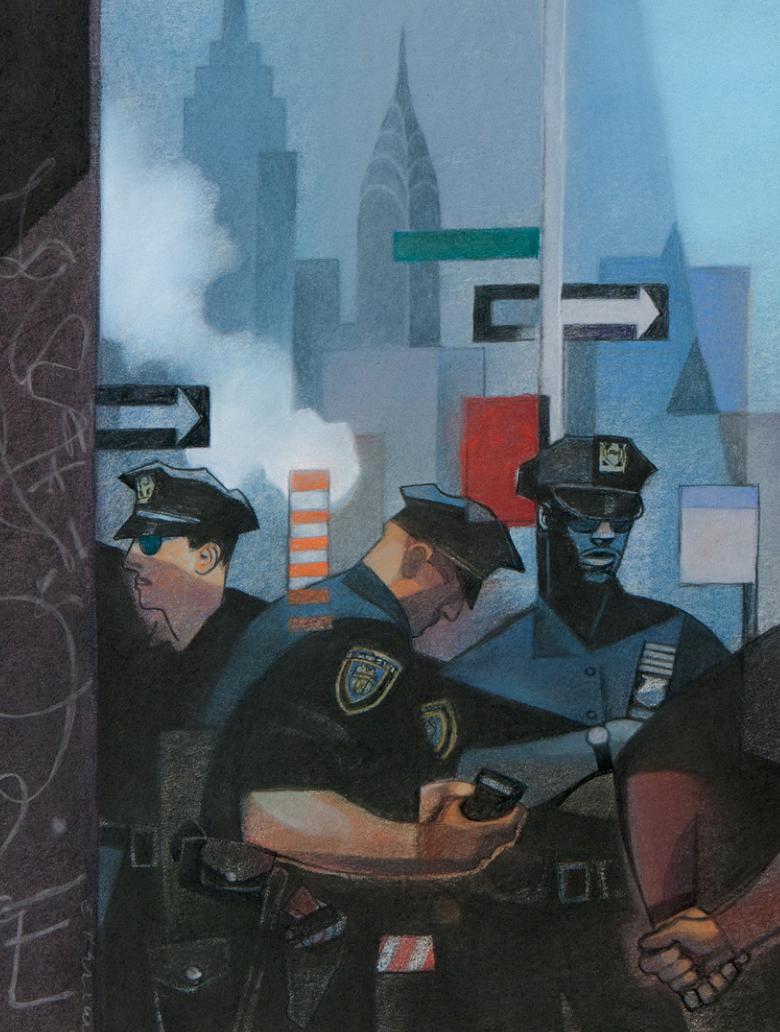
© 2011 Scientific American
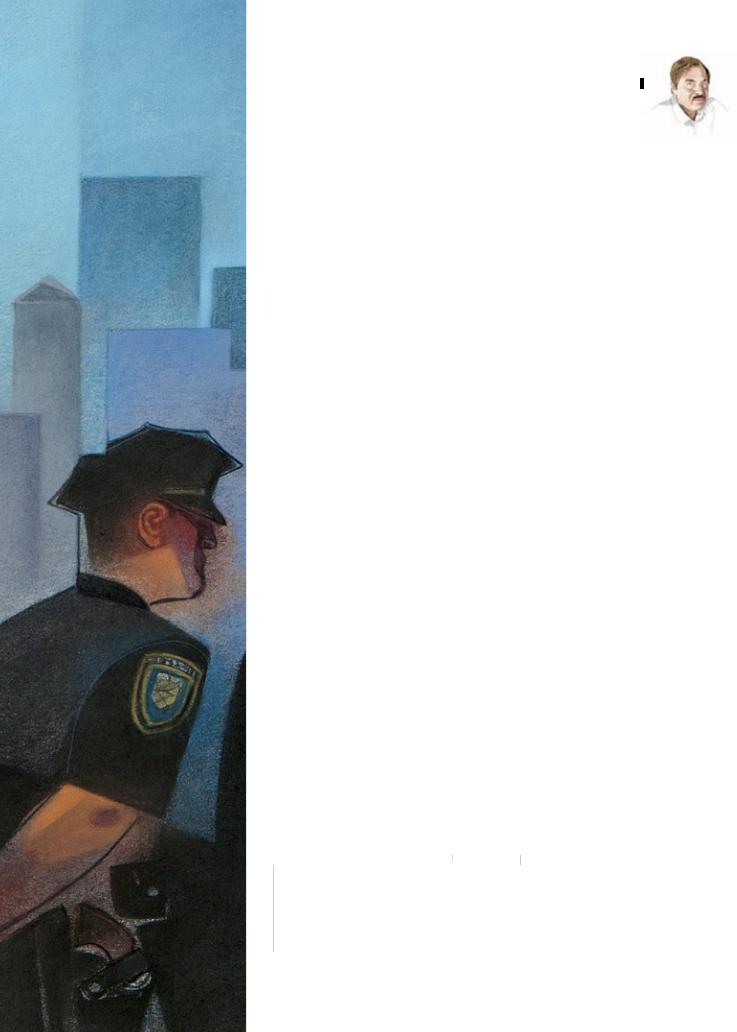
Franklin E. Zimring is a professor at the University of California, Berkeley, School of Law. He is author or co-author of several books on topics, including capit punishment, the scale of imprisonment, and drug control. Zimring wrote a 1991 ScientificAmericanarti
punishment, the scale of imprisonment, and drug control. Zimring wrote a 1991 ScientificAmericanarti onfirearmsandviolence.
onfirearmsandviolence.
S O C I O LO GY
How NewYork
Beat Crime
With its judicious use of cops and innovative methods, the Big Apple is a model for how to stem homicides, muggings and other ills
By Franklin E. Zimring
For the past two decades new yorkers have been the beneficiaries of the largest and longest sustained drop in street crime ever experienced by a big city in the developed world. In less than a generation, rates of several common crimes that inspire public fear—homicide, robbery and burglary—dropped by more than 80 percent. By 2009 the homicide rate was lower than it had been in 1961. The risk of being robbed was less than one sixth of its 1990 level, and the risk of
car theft had declined to one sixteenth.
Twenty years ago most criminologists and sociologists would have doubted that a metropolis could reduce this kind of crime by so much. Although the scale of New York City’s success is now well known and documented, most people may not realize that the city’s experience showed many of modern America’s dominant assumptions con-
|
IN BRIEF |
|
In the 1990s rates of the most |
New York’s successes have de- |
ple are not hardwired to be crimi- |
common crimes plunged in most |
fied common assumptions, such |
nals and suggests that other cities |
of the U.S., but in New York City |
as that drug use fosters crime and |
might achieve similar results by |
the drop has lasted twice as long |
that locking people up reduces it. |
putting more cops on the streets, |
and has gone twice as deep. |
The city’s story shows that peo- |
especially at“hotspots”of crime. |
Illustrations by Gary Kelly |
August 2011, ScientificAmerican.com 75 |
|
© 2011 Scientific American

CRIME DATA
A Citywide
Cool-Off
Crime rates fell across the U.S. throughout |
* |
|
the 1990s, but in New York they kept falling |
|
|
for another decade, and the decline went |
|
|
twice as deep as in most other big cities. |
|
|
Here a combined index of the six most seri- |
|
|
ous crimes (homicide, rape, assault, car theft, |
|
|
burglary and robbery) is displayed by police |
|
|
district. The most dangerous neighbor- |
|
|
hoods, in Brooklyn and the Bronx, typically |
|
|
showed the biggest improvements. |
|
|
[See details of the calculations, as well as |
|
|
more maps and data,at ScientificAmerican. |
|
|
com/aug2011/crime.] |
|
|
Combined Index of 6 Major Crime Types |
|
|
|
|
*The 33rd Precinct |
|
|
was created in 1994. |
High |
Low |
In 1990 it was still |
|
|
a part of the 34th. |
Urban Myths, Shattered
Severalcommonassumptionsabouthowbesttofightcrime—such asloweringdruguse,reducingpovertyandunemploymentorlock- ingmorepeopleup—havebeenprovedwrongbyNewYork’snum- bers:thecitycutdowncrimeby80percentinthepasttwodecades withoutmakingsignificantchangesalongthoselines.Still,toimprovethingsmuchfurther,NewYorkmayneedtotackledeeper socialissuessuchasincomeinequalities,racialsegregationand thequalityofeducation.
Drug overdose deaths showed nothinglikethe80percentdropin crime;drugusewasroughlyconstant.
cerning crime to be flat wrong, including that lowering crime requires first tackling poverty, unemployment and drug use and that it requires throwing many people in jail or moving minorities out of city centers. Instead New York made giant strides toward solving its crime problem without major changes in its racial and ethnic profile; it did so without lowering poverty and unemployment more than other cities; and it did so without either winning its war on drugs or participating in the mass incarceration that has taken place throughout the rest of the nation.
To be sure, the city would be even better off, not to mention safer, if it could solve its deeper social problems—improve its schools, reduce income inequalities and enhance living conditions in the worst neighborhoods. But a hopeful message from New York’s experience is that most crimes are largely a result of circumstances that can be changed without making expensive structural and social changes. People are not doomed to commit crimes, and communities are not hardwired by their ethnic, genetic or socioeconomic character to be at risk. Moreover, the systematic changes that the city has made in its effort to reduce crime are not extremely expensive and can be adapted to conditions in other metropolises.
76 Scientific American, August 2011
A TRUE DECLINE
the first nine years of New York City’s crime decline were part of a much broader national trend, an overall drop of nearly 40 percent that started in the early 1990s and ended in 2000. It was the longest and largest nationwide crime drop in modern history. What sets New York apart from this general pattern is that its decline was twice as large as the national trend and lasted twice as long.
That extraordinary difference—between drops of 40 and 80 percent—can be seen in comparing homicide rates from 1990 and 2009 in the five largest cities in the U.S.: New York, Houston, Philadelphia, Chicago and Los Angeles. The great crime decline of the 1990s reduced homicide in all five cities, in four of those by a substantial amount. But New York went from being dead center in its homicide rates in 1990 to being the lowest of the five—more than 30 percent below the next best city and only 40 percent of the mean rate for the other four places.
Of course, official crime statistics are generated and verified by the same police departments that get credit when crime rates fall and blame when they increase. And indeed, allegations of the New York City Police Department (NYPD) fudging data to make the numbers look pretty have received much media attention. But
Maps by XNR Productions, Graphic by Jen Christiansen
SOURCE: NEW YORK CITY POLICE DEPARTMENT (raw crime data by precinct)
© 2011 Scientific American
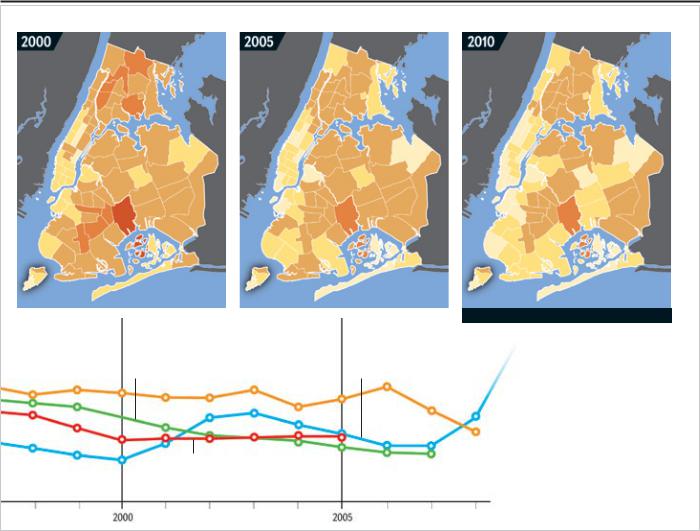
|
|
|
|
|
Incarceration rates (per100,000 |
Unemployment followed |
|||
residents)peakedin1997andthen |
theswingsoftheeconomybut |
|||
declined,buckingthenationaltrend |
apparentlyhadlittleeffectoncrime |
|||
Poverty rates areoften blamedforcrime,butthe datashownocorrelation
How It Happened
Whatmayhavemadeadifferencefor NewYorkcrimewaspolicingand,in particular,afocuson“hotspots.”The NYPDcompileddetailedcrimestatisticsinrealtimeandusedthedatato systematicallyfocusitseffortsonthe mostdangerousstreetcorners.(Havingmorecopsonthestreetsmayhave alsohelpedinthe1990s,butcrimecontinuedtodropevenwhenNYPDrolls fellbacksomewhatduringthe2000s.)
LABOR STATISTICS (unemployment); OFFICE OF VITAL STATISTICS, NEW YORK CITY DEPARTMENT OF HEALTH AND MENTAL HYGIENE (drug deaths)
NEW YORK STATE ARCHIVES; AND BUREAU OF JUSTICE (incarceration); CURRENT POPULATION STUDY, U.S. CENSUS BUREAU (poverty); BUREAU OF
SOURCES: NEW YORK STATE DEPARTMENT OF CORRECTIONS AND COMMUNITY SUPERVISION; NEW YORK CITY DEPARTMENT OF CORRECTION;
anecdotal evidence of police misconduct arises frequently in other places as well, including many American cities where the official numbers are not as rosy. Still, how can we be confident that the spectacularly good news reflects the reality of street crime?
The best method to verify trends is with independent data. Fortunately, agencies apart from the police have kept track of two key crime indices, and their findings have corroborated the NYPD’s data. First, county health departments keep meticulous records of all deaths and provide specific reports of what the police classify as murder and “nonnegligent” manslaughter. Over the 19 years when the police reported the dramatic decline in most crimes, the agreement between the health and police reports each year was practically perfect. In the second case, auto theft (which went down by a spectacular 94 percent), insurance companies record claims by victims. I obtained reports of theft and loss by year from two separate industry data bureaus. The most complete statistics of insurance claims indicated a decline in theft rates of slightly more than 90 percent.
I also found independent evidence for the big drop in robbery. Whereas simple robberies are reported at the police precinct level, killings from robberies are reported independently by a city-
wide police office, which also provides data to the FBI—and they are harder to conceal. The rate of killings from robberies fell more than 84 percent in all robberies. Victim surveys also have confirmed the dip in both robberies and burglaries (which are breakins, usually in which the crime victims are not around, whereas robberies involve a direct encounter with the victim) in the city.
By American standards, then, New York City has become a safe, low-crime urban environment. How did this happen?
GOTHAM CRIME MYTHS
the part of new york’s crime drop that paralleled the larger national downturn of the 1990s did not seem to have any distinctive local causes. The decline was not easy to tie to specific causes either at the national level or in the city, but the same mix of increased incarceration, higher prosperity, aging population and mysterious cyclical influences probably was responsible in both cases.
What caused the roughly half of New York City’s decline that was distinctively a local phenomenon may be easier to single out, as we will see. The answers, however, are not what many people would expect.
August 2011, ScientificAmerican.com 77
© 2011 Scientific American

For example, very few drastic changes occurred in the ethnic makeup of the population, the economy, schools or housing in the city during the 20 years after 1990. The percentage of the population in the most arrest-prone age bracket, between 15 and 29, declined at essentially the same rate as it did nationally, and economic growth did not reduce either poverty or unemployment in New York significantly below the national average.
A common assumption is that the U.S.’s inner cities became safer because they were “cleaned up,” or gentrified—which is when formerly blighted neighborhoods begin to attract people of higher income, and lower-income populations are progressively pushed out by increases in rents and property taxes. During gentrification, so goes the think-
ing, all the poor people leave, driving down crime rates. And indeed, in Manhattan, the city’s wealthiest borough, crime rates dropped along with ethnic and economic diversity. But in the other three most populous boroughs (Queens, Brooklyn and the Bronx), diversity did not drop; if anything, it increased. And yet crime went way down—and at comparable rates—in all four of those boroughs.
The momentous drop in street crime—especially certain kinds—is surprising in another respect. New York has been the illicit-drug-use capital of North America for at least seven decades. By all accounts, it continues to be. In the 1980s the widespread introduction of crack cocaine was associated with sharp increases in homicide. The perceived close link between drugs and violence was one of the animating theories for the War on Drugs that was declared in the decade after 1985. From the perspective of the late 1980s, a significant reduction
in violence without massive reductions in the sale and use of illegal drugs would have been an impossible dream. But that is exactly what seems to have happened in New York.
Drug-related killings (such as dealers shooting one another) dropped 90 percent from peak rates. Meanwhile drug use appears to have stayed relatively stable in the city, whether the indicator is overdose deaths, hospital discharges for drug treatment, or urine tests of criminal suspects. New York seems to be winning the war on crime without winning the war on drugs.
Finally, and perhaps most remarkably, the city’s successful crime policies bucked the national trend toward locking up more and more people. The policy tactics that have dominated crime control in the U.S. assume that high-risk youth will become criminal offenders no matter what we do and that criminals will continue to commit crimes unless they are put away. In the mid-1990s proponents of the “supply side” theory of crime were warning that cities such as New York with high numbers of minority youth growing up in single-parent fami-
lies would require massive new investments in prisons and juvenile facilities. Since 1972 these supply-side theories were the central justification of the sevenfold expansion of imprisonment in the U.S. In the 1980s New York participated in the trend. But in the 1990s, while the U.S. prison and jail population expanded by half, New York went its own way. In the first seven years of the decade its incarceration rate rose only 15 percent, and then it began to fall. By 2008 it was 28 percent below the 1990 rate; nationally, incarceration was up 65 percent.
So where have all the criminals gone?
Many of them just seem to have given up on breaking the law. The rate at which former prisoners from New York were reconvicted because of a felony three years after release—which had increased during the late 1980s— dropped by 64 percent over the years after 1990. The NYPD still catches criminals, and prosecutors and judges still send them to jail.
But the city has reduced its most serious crimes by 80 percent without any net increase in prison populations. These numbers disprove the central tenets of supply-side crime control.
ESTIMATING
POLICE EFFECTS
the one aspect of crime policy wherein the municipal government enacted big changes—and the only obvious candidate to take credit for the city’s crime decline—was policing. Beginning in 1990, the city added more than 7,000 new uniformed cops and made its police efforts much more aggressive and focused on high-crime settings.
The presence of more police on the street was originally thought to have caused most of the New York
decline in the 1990s. But because at that time crime was abating everywhere in the nation, it is hard to know how much of New York’s success stemmed from its own policing changes as opposed to the same mysterious set of causes that operated nationally. Moreover, after 2000 the NYPD actually cut its force by more than 4,000 uniformed officers, and yet reported crime kept dropping and doing so faster than in other large cities.
Nevertheless, a close look at the data after 2000 does point to the importance of policing. In spite of the loss of 4,000 officers, the most recent period still has substantially more police on the street compared with 1990. And the number of police relative to the amount of crime kept growing because crime slowed faster than police rolls shrunk. It is also possible that the cumulative effects of increased manpower lasted into the decade when force levels went down. And the impact of cops is reflected in the fact that New York City experienced the largest drops in the crimes that happen on the street or require access from the street—burglary, robbery and auto theft—
78 Scientific American, August 2011
© 2011 Scientific American

and thus are especially deterred by increased police presence. The police department did not only add more cops on the streets, it also implemented a number of new strategies. It is difficult to determine how much credit, if any, each of the policing
changes should get, but some clear indications have appeared. Once again, the simple explanations are not of much help.
Some of the authorities’ more prominent campaigns were, in fact, little more than slogans, including “zero tolerance” and the “broken windows” strategy—the theory that measures such as fixing windows, cleaning up graffiti and cracking down on petty crimes prevents a neighborhood from entering into a spiral of dilapidation and decay and ultimately results in fewer serious crimes. For instance, the NYPD did not increase arrests for prostitution and was not consistent over time in its enforcement of gambling or other vice crimes.
But other campaigns seem to have had a significant effect on crime. Had the city followed through on its broken-windows policing, it would have concentrated precious resources in marginal neighborhoods rather than in those with the highest crime. In fact, the police did the opposite: they emphasized “hotspots,” a strategy that had been proved effective in other cities and that almost certainly made a substantial contribution in New York. Starting in 1994,
the city also adopted a management and data-mapping system called CompStat. At a central office in downtown Manhattan, analysts compile data on serious crimes, including their exact locations, and map them to identify significant concentrations of crime. Patrols then deploy in full force on-site—whether it is a sidewalk, a bar or any other public place—sometimes for weeks at a time, systematically stopping and frisking anyone who looks suspicious and staring down everyone else. Although one might expect that criminals would just move to another street and resume their business as usual, that is not what happened in New York. Thus, crimes prevented one
day at a particular location do not ineluctably have to be committed somewhere else the day after.
The biggest and most costly change in police tactics is the aggressive program of street stops and misdemeanor arrests that the police use in almost every patrol operation. In 2009 New York’s finest made more than half a million stops and nearly a quarter of a million misdemeanor arrests. The police believe these tactics help to prevent crime. Aggressive patrol, however, has a history almost as long as that of street policing itself, and its effectiveness has not always been clear. Although it could in principle be more effective in New York than in other places, the evidence that it adds distinctive value to the hotspots and CompStat strategies is not strong.
LESSONS LEARNED
to establish conclusively what works and what does not will require scientific field tests measuring the effectiveness of additional manpower and of other techniques from the NYPD’s full kitchen sink of tactics. Then there should be trial-and-error adaptations to other urban settings. But even this early in the game, several lessons from New York City should have a significant influence on crime policy elsewhere.
First of all, cops matter. For at least a generation, the conventional wisdom in American criminal justice doubted the
ability of urban police to make a significant or sustained dent in urban crime. The details on cost-effectiveness and best tactics have yet to be established, but investments in policing apparently carry at least as much promise as investments in other branches of crime control in the U.S.
Two other important lessons are that reducing crime does not require reducing the use of drugs or sending massive numbers of people to jail. Incidentally, the difference between New York’s incarceration trends and those of the rest of the nation— and the money that the city and state governments avoided pouring into the correctional business—has more than paid for the city’s expanded police force.
Unfortunately, New York’s successes in crime control have come at a cost, and that cost was spread unevenly over the city’s neighborhoods and ethnic populations. Police aggressiveness is a very regressive tax: the street stops, bullying and pretext-based arrests fall disproportionately on young men of color in their
own neighborhoods, as well as in other parts of the city where they may venture. But the benefits of reduced crime also disproportionately favor the poor—ironically, the same largely dark-skinned young males who suffer most from police aggression now have lower death rates from violence and lower rates of going to prison than in other cities. We do not yet know whether or how much these benefits depend on extra police aggression.
If New York continues on the same path, it may be able to achieve even greater reductions in crime. After all, even after its vast improvements, its homicide rate is still much higher than those of most major European cities and six times higher than Tokyo’s. At some point, though, it is possible that rates could reach a hard bottom, beyond which further progress could require solving the deeper social problems, such as economic inequality, racial segregation, or lack of access to quality education.
Perhaps the most optimistic lesson to take from New York’s experience is that high rates of homicides and muggings are not hardwired into a city’s populations, cultures and institutions. The steady, significant and cumulatively overwhelming crime decline in New York is proof that cities as we know them need not be incubators of robbery, rape and mayhem. Moreover, it demonstrates that the environment in which people are raised does not doom them to a lifetime outside the law—and that neither do their genes. That result is a fundamental surprise to many students of the American city and is the most hopeful insight of criminological science in a century. 
M O R E T O E X P L O R E
Fairness and Effectiveness in Policing: The Evidence. Edited by Wesley Skogan and Kathleen Frydl. National Academies Press, 2004.
The Crime Drop in America. Second edition. Edited by Alfred Blumstein and Joel Wallman. Cambridge University Press, 2006.
NewYorkMurderMystery:TheTrueStorybehindtheCrimeCrashofthe1990s.Andrew Karmen. New York University Press, 2006.
TheGreatAmericanCrimeDecline.Franklin E. Zimring. Oxford University Press, 2008.
TheCityThatBecameSafe:WhatNewYorkTeachesaboutUrbanCrimeandItsControl.
Franklin E. Zimring. Oxford University Press (in press).
SCIENTIFIC AMERICAN ONLINE
Explore more data and hear an interview with the author at ScientificAmerican.com/aug2011/crime
August 2011, ScientificAmerican.com 79
© 2011 Scientific American

Fractals, such as this stack of spheres created using 3-D modeling software, are one of the mathematical structures that were invented for abstract reasons yet manage to capture reality.
80 Scientific American, August 2011
© 2011 Scientific American

Mario Livio is a theoretical astrophysicist at the Space Telescope Science Institute in Baltimore. He has studied a wide range of cosmic phenomena, ranging from dark energy and supernova explosions to extrasolar planets and accretion onto white dwarfs,
WhyP H I LOSO P H Y O F SC I E N C E neutron stars and black holes.
Math Works
Is math invented or discovered?
A leading astrophysicist suggests that the answer to the millennia-old question is both
Most of us take it for granted that math works—that sci entists can devise formulas to describe subatomic events or that engineers can calcu late paths for spacecraft. We accept the view, initially es
poused by Galileo, that mathematics is the language of science and expect that its grammar explains experi mental results and even predicts novel phenomena. The power of mathematics, though, is nothing short of astonishing. Consider, for example, Scottish physicist James Clerk Maxwell’s famed equations: not only do these four expressions summarize all that was known of electromagnetism in the 1860s, they also anticipat ed the existence of radio waves two decades before
German physicist Heinrich Hertz detected them. Very few languages are as effective, able to articulate vol umes’ worth of material so succinctly and with such precision. Albert Einstein pondered, “How is it possi ble that mathematics, a product of human thought that is independent of experience, fits so excellently the objects of physical reality?”
As a working theoretical astrophysicist, I encoun ter the seemingly “unreasonable effectiveness of math ematics,” as Nobel laureate physicist Eugene Wigner called it in 1960, in every step of my job. Whether I am struggling to understand which progenitor systems produce the stellar explosions known as type Ia super novae or calculating the fate of Earth when our sun ul timately becomes a red giant, the tools I use and the models I develop are mathematical. The uncanny way
The deepest mysteries are often the things we take for granted. Most people never think twice about the fact that scientists use mathematics to describe and explain the world. But why should that be the case?
IN BRIEF
Math concepts developed for purely abstract reasons turn out to explain real phenomena. Their utility, as physicist Eugene Wigner once wrote, “is a wonderful gift which we neither understand nor deserve.”
Part of the puzzle is the question of whether mathematics is an invention (a creation of the human mind) or a discovery (something that exists independently of us). The author suggests it is both.
Illustration by Tom Beddard |
August 2011, ScientificAmerican.com 81 |
© 2011 Scientific American
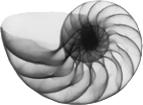
that math captures the natural world has fascinated me through out my career, and about 10 years ago I resolved to look into the issue more deeply.
At the core of this mystery lies an argument that mathemati cians, physicists, philosophers and cognitive scientists have had for centuries: Is math an invented set of tools, as Einstein be lieved? Or does it actually exist in some abstract realm, with hu mans merely discovering its truths? Many great mathemati cians—including David Hilbert, Georg Cantor and the group known as Nicolas Bourbaki—have shared Einstein’s view, associ ated with a school of thought called Formalism. But other illustri ous thinkers—among them Godfrey Harold Hardy, Roger Pen rose and Kurt Gödel—have held the opposite view, Platonism.
This debate about the nature of mathematics rages on today and seems to elude an answer. I believe that by asking simply whether mathematics is invented or discovered, we ignore the possibility of a more intricate answer: both invention and dis covery play a crucial role. I posit that together they account for why math works so well. Although eliminating the dichotomy between invention and discovery does not fully explain the un reasonable effectiveness of mathematics, the problem is so pro found that even a partial step toward solving it is progress.
INVENTION AND DISCOVERY mathematics is unreasonably effective in two distinct ways, one I think of as active and the other as passive. Sometimes scientists create methods specifically for quantifying real-world phenome na. For example, Isaac Newton formulated calculus for the pur pose of capturing motion and change, breaking them up into in finitesimally small frame-by-frame sequences. Of course, such ac tive inventions are effective; the tools are, after all, made to order. What is surprising, however, is their stupendous accuracy in some cases. Take, for instance, quantum electrodynamics, the mathe matical theory developed to describe how light and matter inter act. When scientists use it to calculate the magnetic moment of the electron, the theoretical value agrees with the most recent experimental value—measured at 1.00115965218073 in the ap propriate units in 2008—to within a few parts per trillion!
Even more astonishing, perhaps, mathematicians sometimes develop entire fields of study with no application in mind, and yet decades, even centuries, later physicists discover that these very branches make sense of their observations. Examples of this kind of passive effectiveness abound. French mathematician Évariste Galois, for example, developed group theory in the early 1800s for the sole purpose of determining the solvability of polynomial equations. Very broadly, groups are algebraic structures made up of sets of objects (say, the integers) united under some operation (for instance, addition) that obey specific rules (among them the existence of an identity element such as 0, which, when added to any integer, gives back that same integer). In 20th-century phys ics, this rather abstract field turned out to be the most fruitful way of categorizing elementary particles—the building blocks of matter. In the 1960s physicists Murray Gell-Mann and Yuval Ne’eman independently showed that a specific group, referred to as SU(3), mirrored a behavior of subatomic particles called had rons—a connection that ultimately laid the foundations for the modern theory of how atomic nuclei are held together.
The study of knots offers another beautiful example of passive effectiveness. Mathematical knots are similar to everyday knots,
82 Scientific American, August 2011
except that they have no loose ends. In the 1860s Lord Kelvin hoped to describe atoms as knot ted tubes of ether. That misguid ed model failed to connect with reality, but mathematicians con tinued to analyze knots for many decades merely as an esoteric arm of pure mathematics. Amaz ingly, knot theory now provides important insights into string theory and loop quantum gravi ty—our current best attempts at articulating a theory of space time that reconciles quantum mechanics with general relativi ty. Similarly, English mathemati cian Hardy’s discoveries in num ber theory advanced the field of cryptography, despite Hardy’s earlier proclamation that “no one
has yet discovered any warlike purpose to be served by the theo ry of numbers.” And in 1854 Bernhard Riemann described nonEuclidean geometries—curious spaces in which parallel lines converge or diverge. More than half a century later Einstein in voked those geometries to build his general theory of relativity.
A pattern emerges: humans invent mathematical concepts by way of abstracting elements from the world around them— shapes, lines, sets, groups, and so forth—either for some specific purpose or simply for fun. They then go on to discover the con nections among those concepts. Because this process of inventing and discovering is man-made—unlike the kind of discovery to which the Platonists subscribe—our mathematics is ultimately based on our perceptions and the mental pictures we can conjure. For instance, we possess an innate talent, called subitizing, for in stantly recognizing quantity, which undoubtedly led to the con cept of number. We are very good at perceiving the edges of indi vidual objects and at distinguishing between straight and curved lines and between different shapes, such as circles and ellipses— abilities that probably led to the development of arithmetic and geometry. So, too, the repeated human experience of cause and ef fect at least partially contributed to the creation of logic and, with it, the notion that certain statements imply the validity of others.
SELECTION AND EVOLUTION
michael atiyah, one of the greatest mathematicians of the 20th century, has presented an elegant thought experiment that re veals just how perception colors which mathematical concepts we embrace—even ones as seemingly fundamental as numbers. Ger man mathematician Leopold Kronecker famously declared, “God created the natural numbers, all else is the work of man.” But imagine if the intelligence in our world resided not with human kind but rather with a singular, isolated jellyfish, floating deep in the Pacific Ocean. Everything in its experience would be continu ous, from the flow of the surrounding water to its fluctuating tem perature and pressure. In such an environment, lacking individu al objects or indeed anything discrete, would the concept of num ber arise? If there were nothing to count, would numbers exist?
Like the jellyfish, we adopt mathematical tools that apply to
EDWARD CHARLES LE GRICE Getty Images
© 2011 Scientific American

our world—a fact that has undoubtedly contributed to the per ceived effectiveness of mathematics. Scientists do not choose an alytical methods arbitrarily but rather on the basis of how well they predict the results of their experiments. When a tennis ball machine shoots out balls, you can use the natural numbers 1, 2, 3, and so on, to describe the flux of balls. When firefighters use a hose, however, they must invoke other concepts, such as volume or weight, to render a meaningful description of the stream. So, too, when distinct subatomic particles collide in a particle accel erator, physicists turn to measures such as energy and momen tum and not to the end number of particles, which would reveal only partial information about how the original particles collid ed because additional particles can be created in the process.
Over time only the best models survive. Failed models—such as French philosopher René Descartes’s attempt to describe the motion of the planets by vortices of cosmic matter—die in their infancy. In contrast, successful models evolve as new information becomes available. For instance, very accurate measurements of the precession of the planet Mercury necessitated an overhaul of Newton’s theory of gravity in the form of Einstein’s general rela tivity. All successful mathematical concepts have a long shelf life: the formula for the surface area of a sphere remains as correct to day as it was when Archimedes proved it around 250 b.c. As a re sult, scientists of any era can search through a vast arsenal of for malisms to find the most appropriate methods.
Not only do scientists cherry-pick solutions, they also tend to select problems that are amenable to mathematical treatment. There exists, however, a whole host of phenomena for which no accurate mathematical predictions are possible, sometimes not even in principle. In economics, for example, many variables—the detailed psychology of the masses, to name one—do not easily lend themselves to quantitative analysis. The predictive value of any theory relies on the constancy of the underlying relations among variables. Our analyses also fail to fully capture systems that develop chaos, in which the tiniest change in the initial condi tions may produce entirely different end results, prohibiting any long-term predictions. Mathematicians have developed statistics and probability to deal with such shortcomings, but mathematics itself is limited, as Austrian logician Gödel famously proved.
SYMMETRY OF NATURE
this careful selection of problems and solutions only partially accounts for mathematics’s success in describing the laws of na ture. Such laws must exist in the first place! Luckily for mathema ticians and physicists alike, universal laws appear to govern our cosmos: an atom 12 billion light-years away behaves just like an atom on Earth; light in the distant past and light today share the same traits; and the same gravitational forces that shaped the universe’s initial structures hold sway over present-day galaxies. Mathematicians and physicists have invented the concept of sym metry to describe this kind of immunity to change.
The laws of physics seem to display symmetry with respect to space and time: They do not depend on where, from which an gle, or when we examine them. They are also identical to all ob servers, irrespective of whether these observers are at rest, mov ing at constant speeds or accelerating. Consequently, the same laws explain our results, whether the experiments occur in Chi na, Alabama or the Andromeda galaxy—and whether we con duct our experiment today or someone else does a billion years
from now. If the universe did not possess these symmetries, any attempt to decipher nature’s grand design—any mathematical model built on our observations—would be doomed because we would have to continuously repeat experiments at every point in space and time.
Even more subtle symmetries, called gauge symmetries, prevail within the laws that describe the subatomic world. For instance, because of the fuzziness of the quantum realm, a giv en particle can be a negatively charged electron or an electri cally neutral neutrino, or a mixture of both—until we measure the electric charge that distinguishes between the two. As it turns out, the laws of nature take the same form when we inter change electrons for neutrinos or any mix of the two. The same holds true for interchanges of other fundamental particles. Without such gauge symmetries, it would have been very diffi cult to provide a theory of the fundamental workings of the cosmos. We would be similarly stuck without locality—the fact that objects in our universe are influenced directly only by their immediate surroundings rather than by distant phenomena. Thanks to locality, we can attempt to assemble a mathematical model of the universe much as we might put together a jigsaw puzzle, starting with a description of the most basic forces among elementary particles and then building on additional pieces of knowledge.
Our current best mathematical attempt at unifying all inter actions calls for yet another symmetry, known as supersymme try. In a universe based on supersymmetry, every known parti cle must have an as yet undiscovered partner. If such partners are discovered (for instance, once the Large Hadron Collider at CERN near Geneva reaches its full energy), it will be yet another triumph for the effectiveness of mathematics.
I started with two basic, interrelated questions: Is mathemat ics invented or discovered? And what gives mathematics its ex planatory and predictive powers? I believe that we know the an swer to the first question. Mathematics is an intricate fusion of inventions and discoveries. Concepts are generally invented, and even though all the correct relations among them existed before their discovery, humans still chose which ones to study. The sec ond question turns out to be even more complex. There is no doubt that the selection of topics we address mathematically has played an important role in math’s perceived effectiveness. But mathematics would not work at all were there no universal fea tures to be discovered. You may now ask: Why are there univer sal laws of nature at all? Or equivalently: Why is our universe governed by certain symmetries and by locality? I truly do not know the answers, except to note that perhaps in a universe without these properties, complexity and life would have never emerged, and we would not be here to ask the question. 
M O R E T O E X P L O R E
The Unreasonable Effectiveness of Mathematics in the Natural Sciences.Eugene Wigner in Communications in Pure and Applied Mathematics, Vol. 13, No. 1, pages 1–14; February 1960.
PiintheSky:Counting,Thinking,andBeing.John D. Barrow. Back Bay Books, 1992.
Creation v.Discovery. Michael Atiyah in Times Higher Education Supplement; September 29, 1995.
IsGodaMathematician?Mario Livio. Simon & Schuster, 2010.
SCIENTIFIC AMERICAN ONLINE
Is mathematics invented, discovered, both or neither? See examples of remarkable mathematical structures that invite this question at ScientificAmerican.com/aug11/livio
August 2011, ScientificAmerican.com 83
© 2011 Scientific American

Q&A SCIENCE TALK
IN BRIEF
who
ZAHI HAWASS
vocation | avocation
Egypt’s minister of state for antiquities
research focus
Hawass brings a bigger-than- lifepersonalitytothequesttofind Cleopatra’stombandother
Egyptian treasures.
big picture
Aconsummatemarketerand political operator as well as an archaeologist, Hawass was acontroversialfigureeven before the revolution.
A R C H A EO LO GY
Guardian of
the Pharoahs
Egypt had a revolution, but Zahi Hawass, the larger-than-life minister of antiquities, is still calling his own shots and making no apologies
Interview by Jeffrey Bartholet
One night in the weeks leading up to then president hosni mubarak’s ouster, looters swarmed the grounds of the Museum of Egyptian Antiquities in Cairo (sometimes called the Cairo museum), and at least one broke into the main building by descending on wires from a skylight. Others rampaged through storerooms at well-known archaeological sites. Panic swept the world of Egyptology.
Ultimately, the looting was not as devastating as some had feared, and many of the country’s treasures were recovered. The chaos, though, focused renewed criticism and exacted an emotional toll on Zahi Hawass, the minister of state for antiquities.
Hawass, a celebrity archaeologist known in the West for his larger-than-life persona in such documentaries and television shows as Chasing Mummies, provided sometimes confused and contradictory information about what was happening to the ancient relics under his guardianship. Some critics attacked him for being part of the old regime. His enemies saw a chance to get rid of him. Hawass resigned his position in early March, then abruptly returned weeks later. The upheavals raise questions about how secure Egyptian antiquities are now and when visi-
tors will feel safe enough to tour the Nile in large numbers again. Jeffrey Bartholet, who reported from Egypt during the unrest in February, spoke to Hawass recently by phone for Scientific American. Excerpts follow.
Scientific American: The former regime is gone, but there is still a lot of uncertainty. Is Egypt now moving in a clearly positive direction?
hawass: I think we are trying. We are doing our best to reach elections for the parliament and a new president.
84 Scientific American, August 2011
© 2011 Scientific American

Photograph by Mikhail Galustov |
August 2011, ScientificAmerican.com 85 |
© 2011 Scientific American

Q&A SCIENCE TALK
What are the improvements you are seeing?
Security is starting to come to the streets now. And people are working really hard for democracy and freedom. I don’t think Egyptians have had this kind of democracy in 5,000 years. It’s the first time that we are really practicing it. I hope that it will not take time to get it right.
You resigned your post in March, then returned. Why?
The reason I resigned was because criminals were looting antiquities at that time, and there was no one to stop them. I was screaming, and no one could help me. At the same time, there were students who needed jobs, and they came in front of my office screaming because they wanted jobs now. All this really made me not want to stay. I came back because I found out that I am a part of antiquities, and antiquities are a part of me.
Was there some specific offer that was made or some suggestion or encouragement that was given?
I found that the government was giving more security, and it was supporting me. The army was supporting me. Now we can see the results of that. Most of the Cairo museum objects that had been looted are back. We are missing only 31 objects from the museum; the rest of the [1,200 or so objects stolen from storerooms and storage vaults] are not really masterpieces.
When the uprising began in Egypt, some feared that we would see
a repeat of Iraq—that Egypt’s treasures and heritage would be looted and destroyed.
Look: Who protected the Cairo museum? Actually it was the young protesters. In Iraq 15,000 artifacts were stolen from the museum. The Egyptians protected their museum with their bodies. That is something we have to keep in mind.
Tell me about how the underground market for antiquities works. Who are the thieves, who are the middlemen, who are the final buyers?
After© 2011the revolution,Scientific AmericanI don’t think there is a market for anything. Before the revolution, there were people who stole objects from Egypt and took them outside of the country. We caught most of them. I returned about 5,000 artifacts from all over the world during the past nine years.
But how does it work? Do foreigners come in and work with criminal rings?
You have to understand that most of modern Egypt is built on top of ancient Egypt. People can do illegal excavations; they dig in their courtyards to find antiquities. But I have put antiquities inspectors in every port and airport to stop people from taking objects outside. And I hired educated guards. And I built 47 storage vaults.
The Hamas government in Gaza sent a delegation recently to return some stolen items, and it turned out the items were fake. Can you tell me about that?
They found two statues, and they brought them to me. I found that they were not genuine, and I gave them back. I thanked them and encouraged them to visit the antiquities of Egypt anytime.
What more can be done internationally to recover items looted since January?
We’ve gotten back the masterpieces. But I met someone from Interpol a few days ago: we’re going to put information about every object out to the whole world. I really think the looters who took the objects were not professional criminals. Therefore, I think the objects will be back. They will not leave Egypt.
You said 31 objects from the Cairo museum are still missing at this point. What are the most significant ones?
The only significant one from the museum is a small head of Queen Nefertiti—a few centimeters high.
The statue of Akhenaton has been returned.
We brought back the statue of Akhenaton holding a stela. And we’ve brought back most of King Tut’s objects that were stolen.
And where were they? Where did you find them?
Those were taken by the looters who entered the museum on the night of January 28. We got the objects of King Tut because there was someone working for the antiquities department who came to me and said that there were looters who wanted to return these objects to me. And the next day he brought a bag with four objects.
Over the years you have carried out a campaign to force interna- tional museums to return Egyptian artifacts. In the wake of the revo lution and looting, some in the West made the argument that items were safer spread around the globe. The Natural History Museum of Basel became the first to return
an artifact since the January revolution. Do you see that as significant?
Very important. It’s a relief from the Old Kingdom, about 4,000 years ago.
You had a role in the former government and are now part of the current government. What is different now, in the day-to-day work of your ministry and the way the country is run?
You know, I am a technician. I am not a politician. I have never been in any party, and I did my job beautifully.
You did have a fairly close working relationship with the former first lady, Suzanne Mubarak. Was she an important political patron for the antiquities department?
No, she had nothing to do with any work in antiquities. I collaborated with her to create the children’s museum in Cairo. We will be finishing the work on this museum two months from now, and it will be the best museum for children in the Middle East.
As we speak now in May, have you been in touch with the former first lady since her husband relinquished power?
I told you, I’m a technician, not a politician. My relationship with the first lady
86 Scientific American, August 2011
© 2011 Scientific American
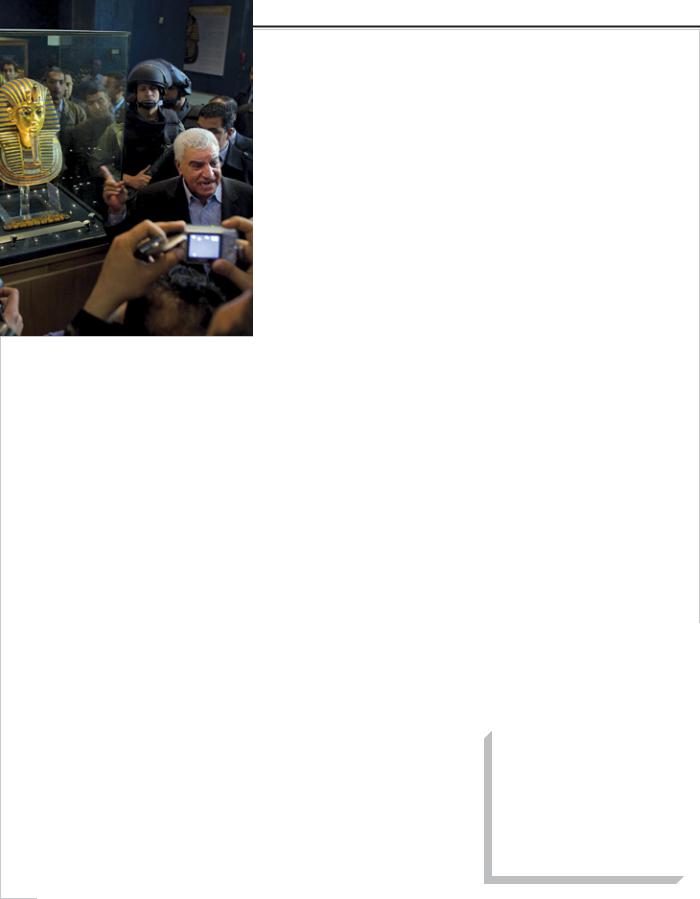
PEDRO UGARTE AFP/Getty Images
Zahi Hawass gives an update on missing artifacts from the Cairo Museum.
was just working in this museum. It wasn’t really close. Many people think I am from the old regime—my enemies say this. But I’m not. I’ve never been a politician my whole life.
But still, you must have a personal sensitivity to seeing her get arrested.
This is something that governments do, and I can’t interfere. Every Egyptian—85 million—can be connected with the old regime. But when you have a new regime that you like, you connect with it.
Has the unrest interfered with archaeological activity in Egypt?
Things are coming back now. Most of the foreign expeditions have applied to work in September and October. Everyone wants to come back and work.
How is the ongoing quest for Cleopatra’s tomb proceeding?
You know, we really did not excavate [in recent months] because of the revolution. But I will continue in September to work in the Valley of the Kings and also continue the excavation to search for the tomb of Cleopatra.
What have you found so far?
We have found statues of Cleopatra and coins of Cleopatra, statues of [Ptolemaic]
kings—and all of these discoveries are very important.
Tell me about the Valley of the Kings. What are you looking for there?
I’m looking for the tomb of Ankhesenamun, the wife of King Tut. I don’t have evidence for it, but I’m hoping that in the next season something might happen.
Now, you mentioned before your critics and enemies. Tell me about them.
I found out [before the revolution] that some people had a very bad reputation in the antiquities department and had been accused in the past of stealing antiquities and things like that. And I really did punish them. When the revolution happened, they could say anything about me. And they started attacking me. And I really did not care and didn’t answer them back. But if you look at these cases, it shows that they are jealous people, and they tried to stop me, but they did not.
You are at the moment appealing a one-year jail sentence for failing to halt bidding by companies interested in running a new gift shop in the museum. Can you tell me about that?
Any government official who tries to protect anything from a civilian, the civilian can take you to court. When the court makes a decision, it’s not against you personally, it’s against your position. But because my name is big, they made it big.
The case concerns the bookshop in the museum?
This man, who had this old bookshop, did not pay us before. I’m not going to say anything about him. But I made a beautiful new shop, and this man didn’t like that.
Some critics say that your governing style is imperious and that you’re overly ambitious. They point to a clothing line you started at one point. Can you respond to that?
People don’t understand the clothing line. First of all, the photo shoot [for the clothing] did not happen at the Cairo museum, as people say. And second, all the money
that comes to me goes to a hospital for children with cancer. I’m very proud that the clothing line became famous and is helping children.
You’re well known for your Indiana Jones–style hat. Is the hat a way
of branding yourself and of branding Egypt?
When I wore this hat, people loved it. I don’t know why. It’s something that became a part of me. I’m very proud that children all over the world buy [replicas of] this hat, and the money goes to the children’s museum.
What do you say to the people who claim that you’re too authoritarian?
If you need to control the antiquities of Egypt, you have to be very strong on the job. If you are not strong, you will never do that. Our antiquities were robbed by everyone before [I came to office]. The antiquities directors were not that strong before. When I do this, I do it for the sake of the antiquities.
Tourism is vital to the Egyptian economy, but at the moment only the most intrepid visitors are touring the Nile. What can be done?
I’m going to use discoveries and the opening of museums to bring tourists back, and at the same time the government will do more to improve the security of the sites. Then people can come back and enjoy the magic and mystery of Egypt. 
Jeffrey Bartholet was formerly Newsweek’s Washington bureau chief and foreign editor.
M O R E T O E X P L O R E
The Pharaoh. Ian Parker in New Yorker; November 16, 2009. www.newyorker.com/reporting/2009/11/16/ 091116fa_fact_parker
Chasing Mummies. A History Channel reality tele vision series featuring Hawass: www.history.com/ shows/chasing-mummies
The blog by Hawass: www.drhawass.com/blogs/ zahi-hawass
SCIENTIFIC AMERICAN ONLINE
Read more of the interview with Hawass at
ScientificAmerican.com/aug2011/hawass
August 2011, ScientificAmerican.com 87
© 2011 Scientific American
